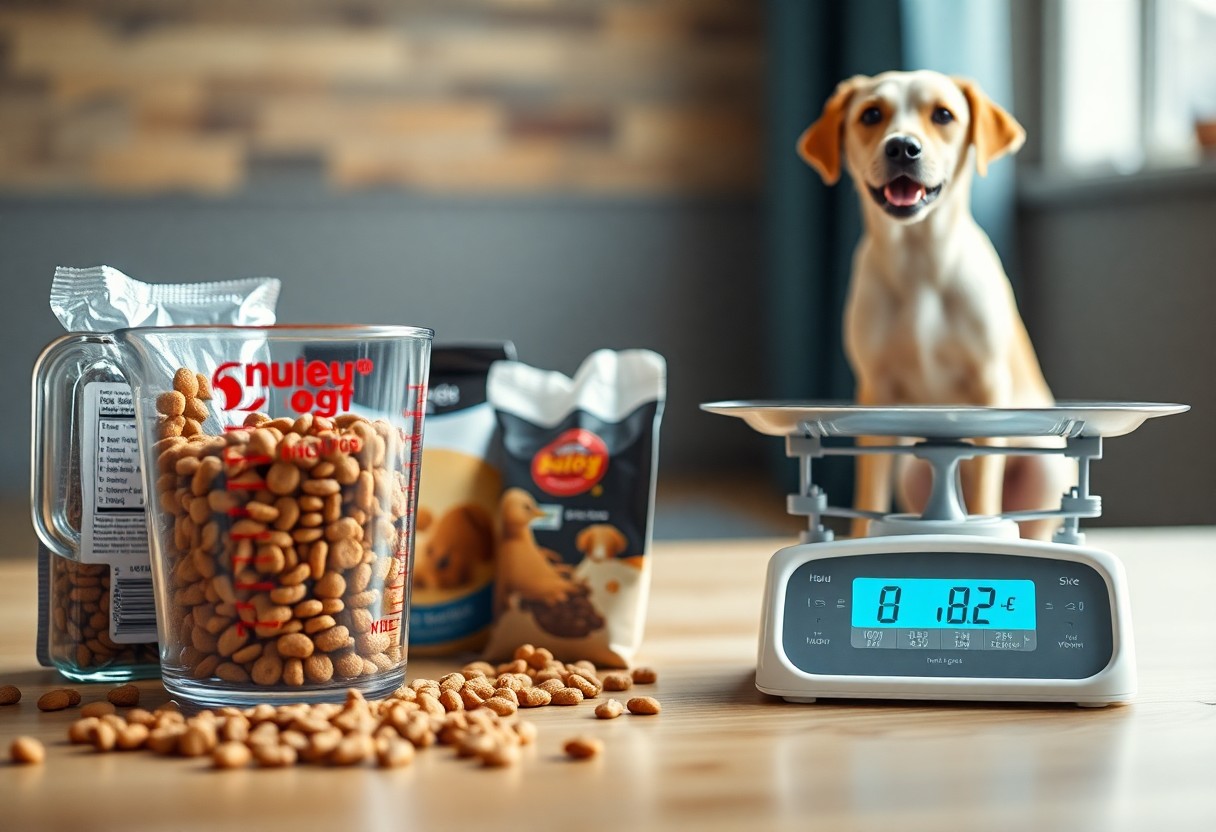There’s a common question among dog owners about how much food to provide their furry companions. The amount of food your dog needs can vary based on factors such as age, breed, size, and activity level. Understanding these variables will help you make informed decisions about your dog’s diet and overall health. In this post, we’ll explore guidelines and considerations to ensure you feed your dog the right amount to maintain a happy and healthy lifestyle.
Understanding Your Dog’s Nutritional Needs
For you to determine the right amount of food for your dog, it’s crucial to understand their unique nutritional needs. Every dog is different, with factors such as age, breed, size, and activity level influencing what they require to thrive. Feeding your dog a balanced diet tailored to these specific needs will promote their overall health and well-being.
Age and Activity Level
Level of physical activity and age are significant factors in determining how much you should feed your dog. Puppies require more calories to support their rapid growth and development, while adult dogs need a balanced diet to maintain energy levels. Additionally, active dogs burn more calories than less active ones, meaning they’ll require larger portions to stay healthy.
Breed-Specific Requirements
An understanding of your dog’s breed can provide important insights into their unique dietary needs. Some breeds have specific nutritional requirements that can affect their growth, energy levels, and health. These requirements can stem from differences in metabolism, predisposition to certain health conditions, or even age-related challenges.
Even within specific breeds, individual dogs can have varying needs; factors such as weight, age, and health conditions can greatly influence their dietary requirements. For example, larger breeds may need diets formulated to support joint health, whereas smaller breeds often have higher metabolism rates that require more frequent feeding schedules. Tailoring your dog’s diet according to these breed-specific insights can lead to a healthier and happier life for your furry friend.
1. Consider your dog’s age, weight, and activity level.
2. Consult packaging for specific breed feeding guidelines.
3. Adjust portions based on your dog’s health needs.
4. Split daily feed into multiple meals for better digestion.
5. Monitor weight and adjust food intake as needed.
6. Provide fresh water alongside meals for hydration.
Calculating Food Portions
Clearly, determining the appropriate food portions for your dog requires attention to various factors including age, size, activity level, and health condition. Begin this process by gathering necessary information about your dog’s lifestyle and dietary needs. Establishing a balanced diet tailored to your dog’s profile will ensure they maintain optimal health and happiness.
Recommended Daily Caloric Intake
Below are general guidelines for your dog’s daily caloric intake based on its weight and activity level. Active dogs require more calories, while less active dogs need fewer. Typically, a rough estimate is around 30 calories per pound of body weight. However, it’s necessary to adjust according to your dog’s specific situation.
Measuring Serving Sizes
By measuring serving sizes accurately, you can ensure your dog receives the right amount of food. Use a standard measuring cup or a food scale for precise portions, which can help prevent overfeeding or underfeeding. Consistency is key when it comes to your dog’s diet.
The importance of measuring serving sizes extends beyond simple portion control; it also plays a vital role in maintaining your dog’s overall health. Over time, improper portion sizes can lead to weight gain, obesity, or nutritional deficiencies. Familiarizing yourself with your dog’s recommended serving sizes and routinely measuring their food can significantly contribute to their well-being and longevity.
Types of Dog Food
To choose the right diet for your dog, it’s vital to understand the different types of dog food available. Each option has its unique benefits and drawbacks, which can influence your dog’s health and well-being. Below is a breakdown of the common types:
| Type of Food | Description |
|---|---|
| Dry Food | Cost-effective and easy to store. |
| Wet Food | High moisture content and palatable. |
| Raw Diet | Whole foods resembling a dog’s natural diet. |
| Processed Food | Cooked, commercially prepared food with additives. |
| Homemade | Prepared by you, ensuring quality ingredients. |
After evaluating your options, you can decide which type aligns best with your dog’s needs and your lifestyle.
Dry vs. Wet Food
Along with the various types of dog food, dry and wet food are typically the most common choices for pet owners. Dry food, or kibble, is convenient, helps with dental health, and can be more budget-friendly. Wet food often has higher protein content, is easier for picky eaters to enjoy, and provides extra hydration. Ultimately, you should consider your dog’s preferences and nutritional needs when choosing between these two options.
Raw vs. Processed Options
Above all, understanding the distinction between raw and processed options can help you make informed dietary choices for your dog. Raw diets typically consist of uncooked meats, bones, and vegetables, mirroring a dog’s ancestral diet. In contrast, processed options are commercially prepared and standardized for convenience. Each choice has specific benefits, so it’s vital to evaluate what’s best for your furry friend.
Understanding the implications of raw versus processed diets is crucial for your pet’s health. Raw diets can lead to improved coat quality and energy levels for some dogs but require careful handling and balanced nutrition to ensure they meet your dog’s dietary needs. Processed foods offer convenience and consistency but may contain fillers and preservatives that aren’t as beneficial to your dog’s overall health. Weigh the pros and cons carefully to find the best fit for your companion.
Feeding Schedules
After determining the right amount of food for your dog, establishing a consistent feeding schedule is crucial for their health and routine. Regular feeding times help regulate your dog’s digestion and can prevent overeating. Typically, adult dogs benefit from two meals a day, while puppies may require more frequent feedings due to their higher energy needs. By sticking to a schedule, you’ll create a comfortable and predictable environment for your furry friend.
Frequency of Meals
Among the factors to consider for your dog’s feeding schedule is the frequency of meals. Generally, adult dogs should eat twice a day, while puppies may need three to four smaller meals to support their growth. As your dog ages, you may choose to adjust the frequency based on their activity levels and dietary needs. Consistency in meal times helps establish a routine, making it easier for you and your pet.
Transitioning to New Food
Along with establishing a feeding schedule, transitioning to new food should be done gradually to avoid digestive upset. When introducing a new diet, mix it with your dog’s current food, starting with a small proportion of the new food. Over about a week, gradually increase the new food while decreasing the old food until fully transitioned.
And as you transition to new food, pay close attention to your dog’s response. Signs of digestive issues, such as diarrhea or vomiting, may indicate that you need to slow down the transition process. It’s crucial to introduce new food gradually, giving your pet’s digestive system time to adjust; this approach not only mitigates discomfort but also helps you ensure that the new food is a good fit for your dog’s specific dietary needs.
Common Feeding Mistakes
Unlike humans, dogs thrive on consistency and moderation in their diets. Many pet owners unknowingly make common feeding mistakes, such as providing excessive treats, feeding human food, or failing to measure portion sizes. These habits can lead to unnecessary weight gain or nutritional deficiencies, impacting your dog’s health. It’s necessary to educate yourself about proper feeding practices to ensure your furry friend leads a healthy and happy life.
Overfeeding vs. Underfeeding
Before adjusting your dog’s food portions, it’s important to understand the fine line between overfeeding and underfeeding. Overfeeding can lead to obesity, while underfeeding can cause malnourishment and energy loss. Keep an eye on your dog’s weight and activity level to find a balanced approach that meets their nutritional needs.
Ignoring Weight Adjustments
Below are various factors influencing your dog’s weight, including their age, activity level, and health status. Neglecting to adjust food portions as your dog ages or their activity level changes can significantly affect their well-being, leading to either excess weight or insufficient nutrition.
Weight management is an ongoing process that requires periodic reassessment of your dog’s diet. As your dog ages or their lifestyle changes, their caloric needs can shift, necessitating adjustments to their food intake. Regularly monitoring your dog’s weight and consulting with your veterinarian can help determine when to alter their portions, ensuring they remain healthy and fit throughout their life.

Monitoring Your Dog’s Health
Not only does your dog’s diet play a vital role in their overall health, but regularly monitoring their wellbeing can provide insights into how well they’re thriving. Close observation of their weight, energy levels, and coat quality can help you determine if you are feeding them appropriately. Document any changes over time and consult with a veterinarian if you notice any concerning trends.
Signs of Proper Nutrition
Above all, healthy dogs exhibit specific signs of proper nutrition, including a shiny coat, bright eyes, and consistent energy levels. You should also look for a healthy weight and firm but not overly prominent ribs. Regular bowel movements and good dental health are additional indicators that your dog is receiving balanced nutrition.
When to Consult a Veterinarian
An important part of monitoring your dog’s health is recognizing when to consult a veterinarian. If you observe significant changes in your dog’s eating habits, weight, or energy levels, it may be time to seek professional advice.
Nutrition plays a foundational role in your dog’s health and wellbeing. If you notice persistent signs such as drastic weight loss or gain, lethargy, or gastrointestinal issues that do not resolve, addressing these concerns with a veterinarian is imperative. They can help determine if there are underlying health issues affecting your dog’s appetite or digestion, ensuring your furry friend receives the care they deserve.
Summing up
On the whole, determining how much food you should feed your dog depends on various factors, including their age, size, activity level, and specific dietary needs. It’s vital to consult your veterinarian and follow established feeding guidelines to ensure your furry friend receives the right nutrition. For comprehensive recommendations tailored to your dog’s needs, check out the Feeding Guidelines — Wholesome Real Food for Dogs. By paying attention to these factors, you can help promote your dog’s overall health and wellbeing.
 wagwagtail "only love can make your dog wag her tail"
wagwagtail "only love can make your dog wag her tail"
